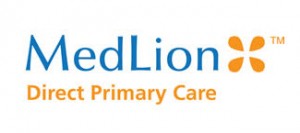Staying with the theme of practice models for independent physicians, here’s an interview with Samir Qamar, MD of MedLion.
Mary Pat: You are the Founder and Chief Executive Officer of MedLion, as well as a practicing Family Physician. Tell us your story.
Dr. Qamar: I grew up around the world the son of a UN diplomat, with a lot of time spent in Europe (including medical school). Growing up, I always wondered why most Europeans never needed insurance for basic medical care. I also learned a lot about the pros and cons of government-run health systems.
During my family medicine residency training at Lancaster General Hospital in Pennsylvania (one of the best programs in the nation), I took the time and effort to also understand the reimbursement system. After realizing obvious faults within it, I became obsessed with finding other models that would not necessitate daily high-volume patient traffic, which in my opinion, led to poorer quality care. “Concierge medicine” was becoming popular (2003), and I saw the advantages to both patients and doctors in this new subscription model. While still a resident, I incorporated my first concierge practice and immediately made headlines for my views on healthcare. Upon graduating from residency, I had made my decision to move to beautiful Monterey, California, where I had a dozen patients waiting for me due to marketing efforts while completing my program.
Within two months, I made local headlines again for starting the first concierge practice in central California, and soon thereafter, became the house physician for the famed Pebble Beach Resorts. In the meantime, my wife, Dr. Hisana Qamar, began her own practice that accepted traditional insurance and Medicare. Both of us grew our respective practices to great success, and were in a unique position to compare the membership model with a traditional model.
In 2009, witnessing the effects of the recession on unemployment (and resulting lack of benefits), I created MedLion Direct Primary Care. I wanted to design an affordable membership model for those with little or no health insurance. It wasn’t long before I realized this model appealed to employers as well, and our company began to grow.
MedLion launched the first direct primary care practices in California. Today, MedLion Direct Primary Care is one of the national leaders in its industry, with practices in multiple states. Without any outside investment, MedLion’s lean business tactics have enabled it to scale quickly, outshining capital-heavy competitors in half the time.
Mary Pat: I was very surprised when I Googled “MedLion” and the first entry on the page said “MedLion – Direct Primary Care – $10 a visit.” First, what is Direct Primary Care?
Dr. Qamar: “Direct Primary Care” is when individuals or employers pay “directly” for “primary care.” Because of this “direct” care, excessive overhead, such as insurance claim processing costs, prior authorizations, billing and coding, extra office space, and unnecessary staff is removed from the business equation. The savings attained are passed on to the patients in the form of lower fees. Doctors are less dependent on third party payers, and end up working in the best interests of patients, not insurance companies.
Mary Pat: How can you provide an office visit for $10?
Dr. Qamar: MedLion revenues are generated from monthly subscription fees. Among the list of services provided under the subscription are $10 office visits. MedLion believes in price transparency, and every patient knows that he or she will be charged $10 for the office visit, whether a full physical, a counseling session, or a simple blood pressure check.
Mary Pat: On your site, you state “Insurance was never meant for primary care.” Will you explain what you mean?
Dr. Qamar: Insurance is the business of risk management via coverage for rare, expensive events. Nearly every industry in this country uses insurance in this manner — except health care. In health care, in addition to covering for rare events like surgeries and accidents, insurance is also used to cover common medical events as routinely encountered in primary care. Whenever insurance is used to cover common events, premiums go up due to claims being filed more frequently. Unfortunately, routine primary care is expensive in the current state, and society is forced to seek health insurance for this as well. This drives up health care costs across the board.
Direct Primary Care is able to make primary care relatively affordable, and thus eliminate the need for costly insurance. Health insurance is reserved for rare, expensive events, like in all other industries. By removing the need for insurance from primary care, which is a significant portion of health care, costs are driven down.
5. Mary Pat: You discuss Telemedicine on your MedLion website – how do you provide care to patients without them coming to the physician’s office and what software do you use for this?
Dr. Qamar: Like most quality medical providers, MedLion has clinics where patients can be seen — but only when necessary. Because MedLion Direct Primary Care does not operate on fee-for-service incentives like most of the country, our practices do not force patients to come in unnecessarily. Most insurance-based practices are not reimbursed unless patients are seen in the office setting. This is why it’s so difficult to get on the phone with the doctor or get a routine refill on a medicine. At MedLion, we reduce unnecessary testing and clinic visits by communicating with our patients outside the practice. If an established patient can safely be treated remotely and the concerns are not serious, telemedicine is practiced. If the patient’s condition is such that the doctor (or the patient) feels it is necessary to be seen, an in-person appointment is made. We use a variety of processes that allow us to perform telemedicine encounters, from simple phone appointments to electronic systems with texts or emails.
Mary Pat: What is the point where direct primary ends and insured care begins?
Dr. Qamar: This is an excellent question. In paying directly for care, the line is drawn when the consumer can no longer afford to pay for services, usually after basic primary care services. Direct primary care can offer affordable provider visits, labs, imaging, and medicine. Care beyond primary care is where insurance comes in handy. Examples are hospitalizations, surgical procedures, and specialist care.
Mary Pat: How does Direct Primary Care work with High Deductible Health Plans and Health Savings Accounts?
Dr. Qamar: Direct Primary Care can complement High Deductible Health Plans (HDHPs), taking care of the primary care component of health care. HDHPs, or major medical plans, can take care of catastrophes. This combination can result in significant savings overall. Health Savings Accounts (HSAs), when structured properly with Direct Primary Care plans, can also be used. The key is working with a Direct Primary Care company, like MedLion, that has unquestionable legal and insurance knowledge.
Mary Pat: I know you are focused on giving employers good value for their money. Can you tell me how Direct Primary Care works for the employer?
Dr. Qamar: MedLion’s Corporate Health Strategies division can do amazing things for employers of all sizes. MedLion’s benefits team can dismantle a company’s insurance plan, insert MedLion Direct Primary Care, and put it back together in a way that can help the company significantly lower costs. We build onsite or near-site clinics for large employers or municipalities. (Currently we are in talks with a company with over 9,000 employees, and are discussing building a clinic for city employees in several states.) We can assist small and mid-sized businesses become self-insured despite not having large reserves, cut healthcare expenses, and circumvent many of the stringent requirements of the Affordable Care Act. MedLion can include workman comp injuries within its Direct Primary Care plans, drastically reducing costs to the employer, as well as the insurance carrier, and we are able to structure agreements with employers in such a way that monthly MedLion fees can become tax-deductible. We can also offer a minimum of affordable primary care benefits to part-time employees, dependents, opted-out full-time employees, early retirees, and independent contractors, all of which keep the entire workforce healthy. Because MedLion practices have protocols for safe and effective telemedicine, in many cases employees can be treated without them having to visit the doctor’s office – increasing productivity for the host company. We also offer wellness programs, occupational health programs, and screenings to employers of all sizes.
Mary Pat: I have written before about the resurgence of physicians starting new private practices – what does the MedLion model offer to physicians wanting to start their own practice?
Dr. Qamar: Unlike most major Direct Primary Care (DPC) companies nationwide, MedLion takes pride in teaching entrepreneurial primary care doctors how to convert, or even start, their own practices. Graduating residents desiring the DPC path are helped as well. We offer Legal Support, Membership Services, Billing and Collections, Marketing and Advertising, Referral Support, Customer Service, and Business Guidance. Several software systems have been specifically chosen for MedLion physicians. Affiliate doctors are able to practice telemedicine, import dictations, create and store electronic records, and retrieve MedLion patient records when needed from other MedLion practices. MedLion will also teach non-EMR practices how to transfer paper charts into electronic records in the most efficient manner possible.
Mary Pat: Why should physicians consider MedLion as opposed to opening a Direct Primary Care practice on their own?
Dr. Qamar: The answer to this is simple. Most doctors have trained in medicine, not business, law, or insurance. Private practice is a business. The new industry of Direct Primary Care is unregulated and requires extensive interpretation and monitoring of continuously changing laws. Most doctors operating on a solo level cannot influence major insurance companies to cooperate, create the best self-insurance plans with Direct Primary Care, and persuade large companies to sign up its employees. Besides the knowledge and manpower required in doing all the aforementioned, it can also be extremely expensive and time-consuming. This is where MedLion can be very valuable for the solo practitioner wanting the benefit s of a Direct Primary Care practice.
MedLion believes a physician should do what they do best – practicing medicine. MedLion was created by physicians, for physicians, in an effort to help resuscitate primary care private practice. Why reinvent the wheel, go through years of trial-and-error, and assume unnecessary risk? With MedLion, doctors have a nationally-reputable partner, and still retain the independence and autonomy so many physicians crave today.
For more information, interested parties may contact MedLion via email, info@medlion.com, or by telephone, (702) 722-6671



